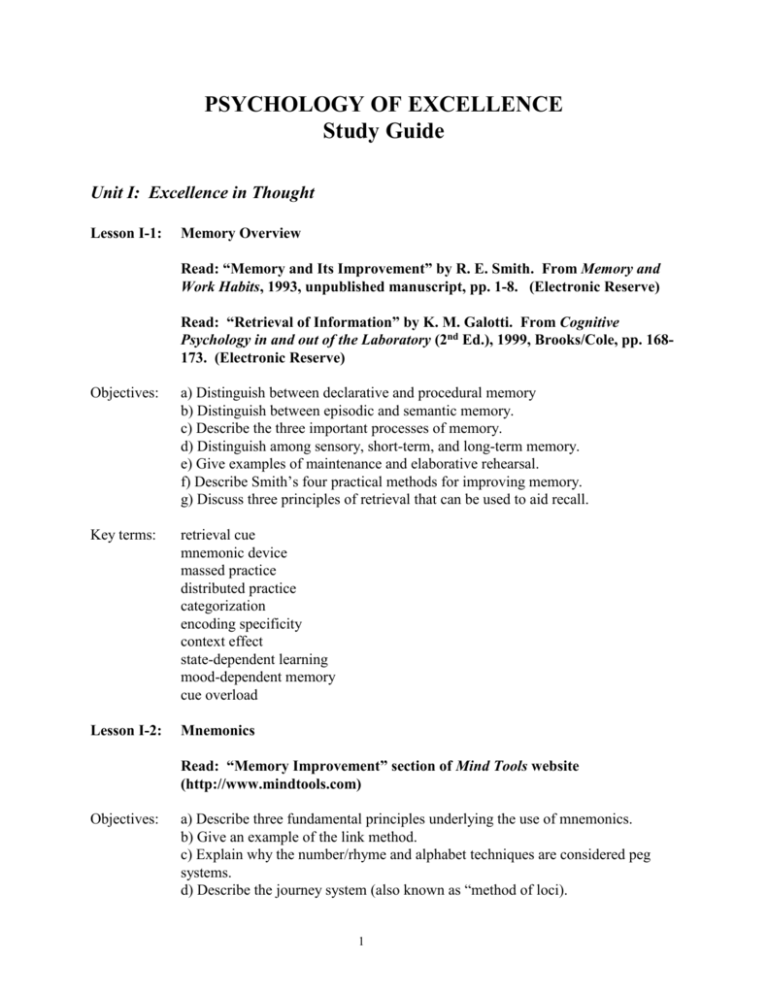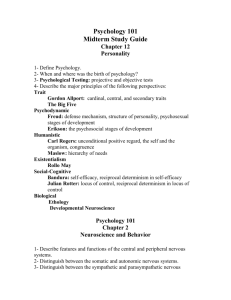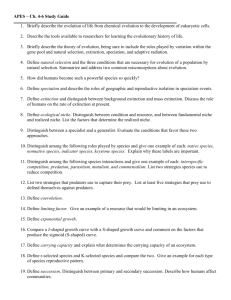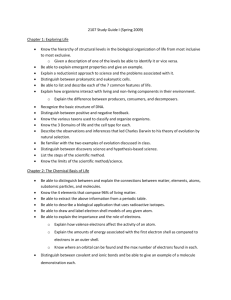Unit I: Excellence in Thought
advertisement

PSYCHOLOGY OF EXCELLENCE Study Guide Unit I: Excellence in Thought Lesson I-1: Memory Overview Read: “Memory and Its Improvement” by R. E. Smith. From Memory and Work Habits, 1993, unpublished manuscript, pp. 1-8. (Electronic Reserve) Read: “Retrieval of Information” by K. M. Galotti. From Cognitive Psychology in and out of the Laboratory (2nd Ed.), 1999, Brooks/Cole, pp. 168173. (Electronic Reserve) Objectives: a) Distinguish between declarative and procedural memory b) Distinguish between episodic and semantic memory. c) Describe the three important processes of memory. d) Distinguish among sensory, short-term, and long-term memory. e) Give examples of maintenance and elaborative rehearsal. f) Describe Smith’s four practical methods for improving memory. g) Discuss three principles of retrieval that can be used to aid recall. Key terms: retrieval cue mnemonic device massed practice distributed practice categorization encoding specificity context effect state-dependent learning mood-dependent memory cue overload Lesson I-2: Mnemonics Read: “Memory Improvement” section of Mind Tools website (http://www.mindtools.com) Objectives: a) Describe three fundamental principles underlying the use of mnemonics. b) Give an example of the link method. c) Explain why the number/rhyme and alphabet techniques are considered peg systems. d) Describe the journey system (also known as “method of loci). 1 e) Discuss a technique used for memorizing long numbers. Key terms: link method number/rhyme mnemonic alphabet mnemonic journey system (method of loci) Lesson I-3: Everyday Reasoning Read “Logic and Everyday Reasoning” by J. Baron. From Thinking and Deciding (2nd Ed.), 1994, Cambridge University Press, pp. 169-184. (Electronic Reserve) Objectives: a) Describe the fallacies of affirming the consequent and denying the antecedent. b) Identify five nonsequeter arguments. c) Discuss Perkins’ “sparse situation modeling” and “search-inference” fallacies. d) Distinguish among the four basic elements of an argument. Key terms: ad hominem straw man begging the question datum claim warrant backing qualifier rebuttal Lesson I-4: Statistical Reasoning Read: “Statistical Reasoning” by A. Garnham & J. Oakhill. From Thinking and Reasoning, 1994, Blackwell, pp. 153-175. (Electronic Reserve) Objectives: a) Describe probability matching. b) Give two possible reasons why people tend to be overconfident about their probability judgments. c) Describe and give examples of Tversky and Kahneman’s three heuristics. d) Explain the phenomenon of regression to the mean. e) Summarize Chapman and Chapman’s findings on illusory correlation. Key terms: hindsight bias heuristic illusory correlation illusory control 2 Lesson I-5: Problem-Solving Overview Read “Problem Solving” by J. Baron. From Thinking and Deciding (2nd Ed.), 1994, Cambridge University Press, pp. 49-73. (Electronic Reserve) Objectives: a) Summarize Thorndike’s and Kohler’s findings. b) Describe the Gestalt view of problem-solving. c) Explain how insight might be related to unconscious processes. d) Distinguish between “suggestion from above” and “suggestion from below.” e) Summarize Duncker’s and Luchins’ findings. f) Discuss Weisberg & Alba’s study of the nine-dot problem. g) Describe four problem-solving methods identified by Newell & Simon. h) Distinguish between the strategies used by novice and expert problem-solvers. i) List Polya’s four heuristics. Key terms: insight functional fixedness Lesson I-6: Problem-Solving Strategies Read: In-Class Handout Objectives: a) Give examples of the problem-solving strategies discussed in class. Lesson I-7: Solving Everyday Problems Read: “Problem-Solving” by M. McKay, M. Davis, & P. Flanning. From Messages, 1995, New Harlinger, pp.83-100. (Electronic Reserve) Objectives: a) Describe each of the five steps of the SOLVE strategy. Key terms: problem Lesson I-8: Creativity Overview Read: “Introduction: An Orientation to the Frontiers of Creativity Research” by S. G. Isaksen. From Frontiers of Creativity Research, 1987, Bearly Limited, pp. 1-31. (Electronic Reserve) Objectives: a) Discuss Rhodes’ classification scheme for the study of creativity. b) List Amabile’s three facets of the creative personality. c) Compare the evaluative and imaginative components of the CPS process. d) Give examples of idea-generating and visualization techniques used to stimulate creativity. e) List two factors that determine the creativity of a product. 3 f) Identify five conditions that are conducive to creativity, according to Torrance. g) Describe the factors that contribute to the creative climate of a group. Lesson I-9: Enhancing Creativity Read: Techniques for Creative Thinking http://members.optusnet.com.au/~charles57/Creative/Techniques/index.html Objectives: a) Describe the following techniques: random input, problem reversal, applied imagination, lateral thinking, six thinking hats, the discontinuity principle, brainstorming, forced relationships, mindmapping, synectics, and assumption smashing. Unit II: Excellence in Action Lesson II-1: Peak Performance Read: Chapter 12 of Applied Sport Psychology (4th Ed.) by J. M. Williams, pp. 162-178. (Required Textbook) Objectives: a) Identify the circumstances in which peak performance is most likely to occur. b) Identify four psychological characteristics associated with peak performance. c) Describe what athletes experience when they are in flow. d) Compare the psychological characteristics of Olympic qualifiers and nonqualifers in men’s gymnastics. e) Discuss the role of anxiety in peak performance. f) Explain what is meant by an “iceberg profile.” g) Describe the conditions in which the iceberg profile predicts performance. h) Explain how IZOFs can be used to increase the likelihood of peak performance. i) Identify the training and competition plans of Canadian Olympic athletes. j) Describe the four types of mental skills used by US Olympic wrestlers. Key terms: peak performance flow external imagery internal imagery Profile of Mood States (POMS) ideographic Individualized Zone of Optimal Functioning (IZOF) Lesson II-2: Goal Setting Read: Chapter 13 of Applied Sport Psychology (4th Ed.) by J. M. Williams, pp. 190-205. (Required Textbook) 4 Objectives: a) Distinguish among subjective, general objective, and specific objective goals. b) Distinguish among outcome, performance, and process goals. c) Discuss the relationship between goal setting and performance. d) Summarize the findings of Botterill (1977) and Burton (1983, 1989). e) Explain how goals influence performance, according to Locke et al (1981). f) Compare the cognitive theories of Burton (1983) and Garland (1985). g) Come up with a set of six goal-setting guidelines. h) Identify common problems associated with goal-setting. Key terms: goal performance expectancy performance valence Lesson II-3: Principles of Self-Regulation Read: “The Principles of Self-Regulation” by D. L. Watson & R. G. Tharp. From Self Directed Behavior (6th Ed.), 1993, Brooks/Cole, pp.103-129. (Electronic Reserve) Objectives: a) Identify three elements of self-regulation. b) Describe each of three phases that occur in learning a behavior. c) Explain what Vygotsky meant by the claim that self-controlling speech “goes underground around the age of five. d) Give an example of a positive and a negative reinforcer. e) Distinguish between escape learning and avoidance learning. f) Identify two types of punishment. g) Distinguish between punishment and negative reinforcement. h) List some of the limitations of punishment as a tool for changing behavior. i) Compare the effects of continuous and intermittent reinforcement on extinction. j) Explain why avoidance learning is resistant to extinction. k) Give an example of stimulus control. l) Explain how respondent conditioning works. m) Give an example of higher-order conditioning. Key terms: cybernetics learned resourcefulness operant behavior reinforcer contingency extinction antecedent discriminative stimulus stimulus control respondent behavior higher-order conditioning 5 modeling Lesson II-4: Self-Regulation of Behavior Read: “Self-Regulation of Behavior” by R. E. Smith. From Enhancing Human Performance, 1993, Self-Published, pp. 15-32. (Electronic Reserve) Objectives: a) Summarize the findings of Lovitt & Curtis (1969) b) Name three types of self-control procedures. c) Give an example of a problem specified in behavioral terms. d) Explain why it is better for self-modification programs to use positive reinforcement instead of punishment. e) Identify at least three guidelines for collecting baseline data. f) Give three reasons why one should collect baseline data before starting a selfmodification program. g) Give examples of stimulus control techniques used in weight control programs and in improving study habits. h) Explain why behavior can begin to change during the baseline period. i) Describe two characteristics of an effective reinforcer. j) Give an example of an effective self-modification contract. k) Discuss the conditions in which the use of tokens can be effective. l) Give an example of an effective shaping schedule. m) Describe an easy way to remedy cheating. Key terms: Premack principle token shaping Lesson II-5: Time Management Read: “Successful Time Management” by R. E. Smith. From Enhancing Human Performance, 1993, Self-Published, pp. 33-42. (Electronic Reserve) Objectives: a) Distinguish between efficiency and effectiveness. b) Explain why time use analysis is needed and describe the process. c) Identify two types of time robbers. d) List the steps involved in setting and prioritizing time management goals. e) Identify two reasons to make a planning guide. f) Describe an effective strategy for scheduling your time. g) Identify a way to avoid procrastination of large tasks (e.g., writing term papers). Key terms: 80/20 misdistribution rule prioritization 6 Lesson II-6: Mental Imagery Read: Chapter 16 of Applied Sport Psychology (4th Ed.) by J. M. Williams, pp. 247-272. (Required Textbook) Objectives: a) Summarize the findings of Marks (1983). b) Cite evidence that imagery enhances performance. c) Describe four theories that explain how imagery enhances performance. d) Cite evidence in support of bioinformational theory. e) Distinguish between the internal and external perspective. f) Describe the conditions in which imagery is most useful. g) List four phases in setting up an imagery program. h) Describe two exercises that are useful in convincing athletes of the merits of practicing imagery. i) Identify the three types of imaging exercises included in Basic Training. j) Give four examples of vividness exercises. k) Give three examples of controllability exercises. l) Give three examples of self-awareness exercises. m) Describe three ways that imagery can enhance physical skills. n) Describe three ways that imagery can enhance perceptual skills. o) Describe 10 ways that imagery can enhance psychological skills. p) Explain how the Energy Room exercise can be used to control arousal. Key terms: imagery polysensory psychoneuromuscular theory symbolic learning theory bioinformational theory stimulus characteristics response characteristics Lesson II-7: Exercise Psychology Read: Chapter 27 of Applied Sport Psychology (4th Ed.) by J. M. Williams, pp. 497-518. (Required Textbook) Objectives: a) List four positive effects of exercise on mental health. b) Identify the physical health risks associated with anxiety and depression. c) Describe the effects of exercise on sleep. d) Identify the factors that determine the effect of exercise on self-esteem. e) Discuss cognitive and biological explanations of how exercise affects mental health. f) Describe the relationship between physical activity and mental stress. 7 g) Summarize the Surgeon General’s findings about activity levels among adult Americans. h) Identify changes in activity level associated with late adolescence. i) Compare the social cognitive, behavioral and cognitive-behavioral theories of exercise behavior. j) List the five stages in the stages-of-change model. k) Identify the personal attributes, environments, and types of physical activity that are associated with activity level. l) Give examples of interventions involving stimulus control, reinforcement control, goal setting, and exercise prescription. m) Describe the intervention goals at each of the five stages of the stages-ofchange model. Key terms: thermogenic hypothesis endorphin opioid norepinephrine (NE) serotonin hypothalamic-pituitary-adrenal (HPA) axis self-efficacy Lesson II-8: Exceptional Conduct Read: “Exceptional Mental Health” by Roger N. Walsh. From What is Enlightenment? by J. White (Ed.), 1984, Tarcher, pp.139-150. (Electronic Reserve) Objectives: a) Describe the relationship between mental health and each of the 10 qualities discussed in this reading. Key terms: Theravadin ducca annica annata Bodhisattva Lesson II-9: Peacemaking Read: “Peacemaking” by David G. Myers. From Social Psychology (6th Ed.), 1999, McGraw-Hill, pp.535-555. (Electronic Reserve) Objectives: a) Name the four C’s of peacemaking. b) Describe the circumstances that are most conducive to inter-group cooperation. c) Compare the following conflict resolution strategies: bargaining, mediation, and arbitration. 8 d) Give an example of a successful application of the GRIT technique. Key terms: equal-status contact superordinate goal bargaining mediation arbitration integrative agreement GRIT Unit III: Excellence in Experience Lesson III-1: Emotional Intelligence Read: “When Smart is Dumb” by Daniel Goleman. From Emotional Intelligence, 1995, Bantam, pp.33-45. (Electronic Reserve) Objectives: a) Describe the relationship between IQ and success. b) Cite experimental evidence that IQ does not predict success. c) Discuss Gardner’s view of intelligence. d) Describe Salovey’s five domains of emotional intelligence. e) Summarize Block’s findings about IQ and emotional aptitude. Lesson III-2: Arousal and Performance Read: Chapter 14 of Applied Sport Psychology (4th Ed.) by J. M. Williams, pp. 206-228. (Required Textbook) Objectives: a) Distinguish between arousal and anxiety. b) Name two factors that affect anxiety levels. c) Describe the physiology of a “fight or flight” response. d) Distinguish between trait anxiety and state anxiety. e) Identify the two components of anxiety. f) Summarize the basic ideas of drive theory and the inverted-U hypothesis. g) Compare multidimensional anxiety theory and the catastrophe cusp model. Key terms: arousal performance disregulation dual-task paradigm Lesson III-3: Relaxation Read: Chapter 15 of Applied Sport Psychology (4th Ed.) by J. M. Williams, pp. 229-246. (Required Textbook) 9 Objectives: a) Summarize the findings of Green & Green (1977). b) Explain how muscle tension can affect performance. c) List two traits that predict an individual’s mastery of relaxation techniques. d) Identify the order of preference of relaxation techniques. e) Distinguish between muscle-to-mind and mind-to-muscle techniques. f) Briefly describe six common breathing techniques. e) Compare active, differential and passive PR techniques. f) Give an example of a simple meditation technique. g) Describe the three stages of AT. h) Explain how breathing, imagery and verbal cues can be used to increase activation and energy. Key terms: autonomic functions double pull differential relaxation zero-activation level progressive relaxation (PR) efferent nerve control mantra relaxation response autogenic training (AT) Lesson III-4: Confidence Read: Chapter 17 of Applied Sport Psychology (4th Ed.) by J. M. Williams, pp. 284-311. (Required Textbook) Objectives: a) Describe the relationship between confidence and athletic success. b) Distinguish among the following terms: confidence, optimism, self-efficacy. c) Discuss five common misconceptions about confidence. d) Describe the four prerequisites for gaining confidence. e) Describe the three dimensions of explanatory style. f) Identify the characteristics of an optimistic explanatory style. g) Name two problems with the use of negative self-labels, according to Ellis. h) Summarize Seligman’s view of depression. i) Compare the use of self-talk in skill acquisition and performance. j) Explain how self-talk can be used to: change a bad habit; control attention; change one’s mood; control effort; and build self-efficacy. k) Describe three techniques for identifying self-talk. l) Give an example of a thought stoppage technique. m) Explain how the techniques of countering and reframing work. n) Describe eight cognitive distortions that are common among athletes. o) Identify two criteria for deciding whether or not self-talk and underlying beliefs are rational. 10 Key terms: explanatory style permanence pervasiveness personalization self-talk thought stoppage polarized thinking self-esteem list success list mastery tape coping tape Lesson III-5: Flow Read: “The Conditions of Flow” by M. Csikszentmihalyi. From Flow, 1990, Harper Perennial, pp.72-93. (Electronic Reserve) Objectives: a) Describe the characteristics of optimal experience (i.e., flow). b) Identify the features of flow activities. c) Distinguish among four types of games. d) Explain the diagram on p. 74. e) Give two examples of the link between flow and religion. f) Explain how flow can be used to evaluate social systems. g) Describe the methods used by Shushwap Indian tribes and the monks of Isé to build flow into their lifestyles. h) Discuss the relationship between flow and virtue. i) Identify three social variables that predict life satisfaction. j) Explain why attentional disorders and self-consciousness prevent flow. k) Describe two states of social pathology that inhibit flow. l) Summarize Hamilton’s findings. m) Describe the five characteristics of family contexts that promote flow. Key terms: autoletic anhedonia anomie Lesson III-6: Meditation Read: “Bringing the Mind Home” by S. Rinpoche. From The Tibetan Book of Living and Dying, 1994, Harper San Francisco, pp. 56-81. (Electronic Reserve) Objectives: a) Explain the purpose of meditation. b) Describe the three principles of effective meditation. c) Identify three things that the practice of mindfulness accomplishes. d) Describe the three steps of meditation practice. 11 e) Distinguish between “method” and “meditation.” f) Identify the elements of good meditation posture, according to the author. g) Describe three methods of meditation. h) Explain how one should deal with thoughts and emotions that arise during meditation. i) Summarize Jamyan Khyentse’s instructions on how to meditate. j) Discuss two pitfalls that may be encountered when practicing meditation. Key terms: samsara prana Lesson III-7: Peak-Experiences and Self-Actualization Read: “Cognition of Being in the Peak-Experiences” by A. H. Maslow. From Toward a Psychology of Being, 1962, Van Nostrand, pp. 67-96. (Electronic Reserve) Objectives: a) Distinguish between B-cognition and D-cognition. b) Identify the characteristics of peak-experiences. c) Discuss the significance of B-values. d) Explain how Maslow defines self-actualization in relation to peak-experiences. e) List seven aftereffects of peak-experiences. Key terms: B-cognition peak-experience B-values microcosm Lesson III-8: Individuation Read: “Summary of Jung’s Psychology” by M. Fonda. http://www.clas.ufl.edu/users/gthursby/fonda/jung03.html Read: “The Individuation Process and the Artist” by L. Strong. http://www.clas.ufl.edu/users/gthursby/fonda/jung03.html Objectives: a) Distinguish between the two aspects of the unconscious. b) Explain the notion of an archetype. c) Describe each of the following archetypes: ego, persona, the shadow, anima, animus, and the self. d) Describe each step of the individuation process. e) Explain the diagram in the handout. Key terms: personal unconscious collective unconscious 12 archetype individuation Lesson III-9: Happiness Read: “The Sources of Happiness” by H. H. The Dalai Lama & H. C. Cutler. From The Art of Happiness, 1998, Riverhead Books, pp. 19-36. (Electronic Reserve) Objectives: a) Cite evidence supporting the process of emotional adaptation. b) Describe the basic ideas of equity theory. c) Summarize the findings of the studies conducted at the University of Wisconsin and the State University of New York at Buffalo. d) Identify the key determinant of happiness, according to the Dalai Lama. e) Distinguish between calmness and apathy. f) Describe the irony of greed. g) Distinguish between happiness and pleasure. h) Summarize Freud’s ideas about pleasure principle. i) Describe the brain’s “pleasure pathway.” j) Briefly explain how pleasure can turn into addiction. Key terms: adaptation equity theory ventral tegmental area (VTA) striatum amygdala hypothalamus orbitofrontal cortex (OFC) 13








